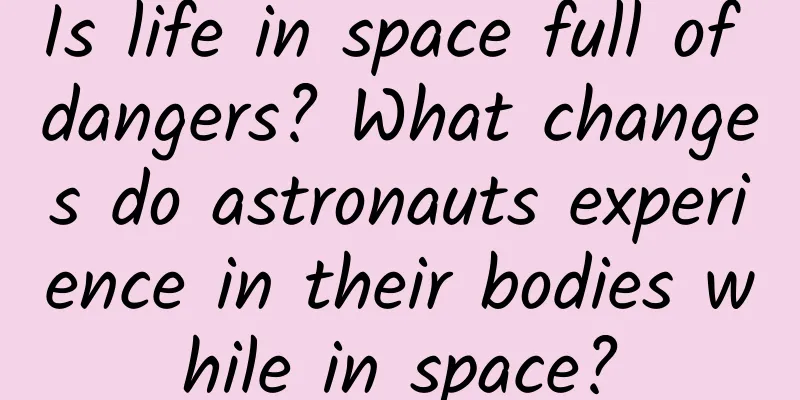Is life in space full of dangers? What changes do astronauts experience in their bodies while in space?

|
The human body is an extremely complex and sophisticated instrument. Nature has given us an unparalleled brain, which allows us to break through the limitations of our own flesh through wisdom, to reach for the moon in the sky and catch turtles in the five oceans; our well-developed sweat glands allow us to run for long periods of time; our flexible hands are our most powerful tools for dominating the earth. These are all great shapings of human beings by nature, but human beings themselves are creatures that do not belong to space. American astronaut Scott Kelly on the International Space Station From ancient apes to us today, our evolution has been carried out in an environment with a g value of 9.8 meters per second. When humans use their wisdom to break free from the shackles of the atmosphere and gravity and come to space, ready to show their talents in the vast universe, we not only have to face obstacles in science and technology, but our own bodies also have to fight against the cruel cosmic environment, which is not easier than developing a spacecraft capable of interstellar travel. "During my last 159-day mission to the space station, I lost bone mass, my muscles atrophied, and blood redistributed throughout my body, which strained and constricted the walls of my heart. Even more disturbing, I developed vision problems, just as many other astronauts have. I was exposed to more than 30 times the radiation a person on Earth receives, the equivalent of about 10 chest X-rays a day, an exposure that increases my risk of developing deadly cancers for the rest of my life." This is NASA astronaut Scott Kelly telling the media about the effects of space travel on his body. When we are on Earth, the easiest way to judge whether something is up or down is to throw an object. The direction it falls is down, and the other side is up. Generally, no one will study this matter in detail. In the space station, because astronauts are in a microgravity environment, they cannot distinguish "up" and "down" by throwing objects. The concept of "up" and "down" in the space station is more of an artificial division, so that astronauts can distinguish and describe. Motion sickness in space "Space adaptation syndrome", referred to as SAS, is a type of motion sickness that occurs in space, or "motion sickness" that occurs in space. Gravity plays an important role in our spatial orientation. Changes in gravity, such as the transition to weightlessness during space travel, affect our sense of spatial orientation and require our body's balance system to function. As long as this adaptation is incomplete, it can lead to motion sickness (nausea), visual illusions and disorientation. German Stepanovich Titov was the second Soviet astronaut to enter space and the first person to vomit in space due to severe motion sickness. He is considered the first SAS patient. The most severe SAS patient known so far is American payload specialist Jack Garn. He suffered extremely severe SAS symptoms during the STS-51 mission of the space shuttle in 1985, so much so that NASA later jokingly used the "Garn Scale" to measure the severity of SAS experienced by astronauts. German Titov, the second Soviet cosmonaut to go into space Jack Garn, American astronaut During his mission in space, American astronaut Garn was almost completely unable to adapt to the microgravity environment. His muscles could not be coordinated in space, his vestibular system could not function properly, and he was unable to judge the distance between himself and objects in front of him. With his eyes closed, he could not determine where to fly or how long it would take to touch the target object. His eyes' ability to judge the distance to objects deteriorated... Well-trained astronauts basically do not reach this level, and these phenomena tend to disappear gradually within 3 days as the body gradually adapts. But it needs to be clarified here that Garn was in good health during the flight and the SAS was not caused by any health problems. He did not show any symptoms during the drills in the microgravity simulator. Susannah Nucky of the Delft University of Technology in the Netherlands has studied the SAS phenomenon. Using centrifuges used in fighter pilot training, she found that people who spend a long time in the high gravity of a human centrifuge develop SAS symptoms. To experience this, people have to spend more than an hour in a centrifuge and be subjected to gravity that is three times higher than on Earth. The rotation itself is not very uncomfortable, but after leaving the centrifuge and stepping onto normal ground, about half of the test subjects will experience the same symptoms as SAS. It turns out that astronauts who suffer from space sickness during space flight also develop these symptoms after a long rotation on Earth. This means that these symptoms are not actually caused by weightlessness itself, but are caused by the body's balance system not adapting to a different gravity environment. Nucky focused her research on the organ in the body that is used to sense balance. It is located in the inner ear and includes the semicircular canals, which are sensitive to rotation, and the otoliths, which are sensitive to linear acceleration. It has been previously proposed that differences between the function of the left and right otoliths would make astronauts more susceptible to illness. Nucky tested this hypothesis of asymmetric otolith function by measuring otolith and semicircular canal function on both sides in 15 subjects known to be susceptible to space sickness. Those who developed space sickness after rotation were shown to have a high degree of otolith asymmetry and a more sensitive otolith and ear canal system. These people could not be classified as sensitive or insensitive based on this asymmetry alone, but rather could be classified based on a combination of various otolith and ear canal characteristics. This suggests that the entire balance organ is involved in space sickness and that it may require a complex interaction between the various parts of the balance organ. When a person is in a state of motion sickness, due to the unclear understanding of spatial distance, there is a high possibility of misoperation when operating precise scientific instruments, resulting in damage to the equipment or more serious injuries to personnel. This is one of the reasons why astronauts are generally selected from pilots with longer flight time. If you are not a professional astronaut, for example, the first person in the world to enter space through commercial means, Japanese TBS reporter Akiyama Toyohiro, entered the Mir space station without any training and suffered from severe space sickness on the first day in space. If an ordinary person rashly enters space, he may faint in his sleeping bag before he has time to appreciate the beauty of our earth. After decades of accumulation of physiological experiments in space, the best way to prevent space sickness is to take dimenhydrinate, use dimenhydrinate patches (Draminate) or similar drugs that can inhibit the activity of the balance system. When astronauts are doing extravehicular activities, they can stick it on their skin. Dimenhydrinate is gradually released into the blood, inhibiting the activity of the balance system, which can greatly alleviate the symptoms of SAS. Bone and muscle loss In our body, osteoclasts and osteoblasts interact and assist each other to maintain the balance and health of human bone density. However, in space, the bones, skeletal muscles and back muscles that should bear the weight of the body no longer function. On Earth, bones are constantly shed and regenerated through a well-balanced system, with a coupled relationship between them. When bones are broken down, newly formed bone layers replace the broken down bone layers, forming a dynamic balance in our bodies. However, in space, due to microgravity, osteoclast activity increases, causing osteoclasts to be more active than osteoblasts. Bones no longer need to provide support for movement or even maintaining body posture, resulting in little or no stress being applied to the skeletal system. People who live in space for a long time will experience progressive bone loss. On the ground, patients who are bedridden for a long time can also suffer from osteoporosis due to insufficient bone stress. The effect of this increased osteoclast activity is particularly evident in areas that bear the greatest load under gravity, such as the pelvis, tibia, and foot areas. The calcium lost from the bones enters the body fluid circulation, and the calcium ions in the body's plasma are gradually deposited in the kidneys as they pass through the glomeruli, greatly increasing the risk of kidney stones. As for muscles, the muscles that are reduced in space are called "antigravity muscles" in NASA documents, that is, muscles that fight gravity, such as calf muscles, quadriceps muscles, back and neck muscles. These muscles support us to stand on the earth, but because there is no gravity, these muscles will hardly contract in space. Without regular exercise, these muscles will become weak and degenerate. This is a process of atrophy. Studies have shown that astronauts lose 20% of their muscles during spaceflight lasting 5 to 11 days. This is very dangerous for astronauts because it means they may not be able to fight the effects of Earth's gravity when they return to Earth. Although muscle mass and strength can be restored after astronauts return to Earth, maintaining muscle in space is a concern, especially during long-term space missions. The only way to reduce muscle atrophy in space is high-intensity exercise, especially strength training, combined with a proper diet. Weakened bones due to a gradual loss of bone mass is a serious risk of extended space flight. Studies of astronauts who spent months on the Mir space station have shown that space travelers may lose 1% to 2% of their bone mass each month. Of course, there are ways to alleviate this. The most direct way is to take vitamin D, bisphosphonates, calcium tablets, and exercise in the space station. Stimulating muscles and bones that cannot be stressed in space, such as space bikes and treadmills, tension bands, resistance bands, etc., has proven to be very effective. Astronauts on the International Space Station spend two and a half hours exercising every day to combat the effects of muscle atrophy. Chinese astronauts prepare for exercise in the core module of Tianhe Astronauts who have been in space for hundreds of days will still have a serious problem of not being able to adapt to gravity after returning to the ground. When they first return to the ground, they will be carried by others to move. Redistribution of body fluids Under the action of gravity, blood and other body fluids are pulled toward the lower body. In space, when gravity disappears, blood tends to gather in the upper body, causing swelling of the face and upper body, etc., and the body will adapt to achieve a new balance. At this time, you will find that astronauts are always swollen in space. Comparison of Chinese astronaut Wang Yaping on the ground and in the space station After the astronauts return to Earth, blood begins to accumulate in the lower limbs again, causing postural hypotension, which is a bit like the feeling of suddenly standing up when you get up in the morning, or suddenly standing up after squatting for a long time, but the body will slowly return to normal. In space, the astronauts' blood volume will also decrease, which will cause the heart to beat slower and induce hypotension. Astronauts will not feel postural hypotension when entering space, but after re-entering the atmosphere and landing, they will clearly feel the blood flowing back to the lower body and the blood pressure in the head suddenly drops, causing dizziness and being unable to adapt to walking upright for a while. The human leg is like a small "heart" that transports blood from the lower limbs upward to the heart to maintain blood pressure. The contraction of the lower limb muscles is an important condition for promoting the flow of venous blood to the heart. Therefore, the lower limb veins are also called the "second heart". However, there is no activity in space that can stimulate the lower limb veins, so the tiny muscles in the veins are rarely used. After returning to the surface, these muscles are mobilized again, but they temporarily "forget" how to contract, that is, they are temporarily unable to push blood back to the heart and brain. This effect is more serious after a long space flight. And this phenomenon also varies from person to person. Some astronauts are hardly affected, while others feel very dizzy. About 20% of short-term space travelers and 83% of long-term space travelers will experience symptoms after re-entry or landing. However, there will be no sequelae, and rehabilitation treatment after landing can return to normal. The blood vessels in the legs are densely packed, so in order to pump the venous blood back to the upper body, the veins in the lower limbs also need to work hard. The pain of growing taller due to weightlessness After about 25 years of age, humans begin to lose height because the spongy discs between the vertebrae in the spine shrink, causing the bones to move closer together. After age 40, the back begins to bend forward. From age 20 to 70, women may shrink by about 5 cm, while men may lose about 2 cm. On Earth, our vertebrae fit very tightly together due to the compression of gravity, but in space, because there is no weight pushing down on the spine, the spacing between each pair of vertebrae increases slightly, resulting in a longer spine, making astronauts "taller." In past U.S. space flights, more than two-thirds of astronauts reported back pain. This back pain may be related to the stretching of the spine. In past space missions, spinal measurements were taken and it was found that astronauts' height could increase by up to 6 to 8 cm compared to their height on Earth, and the normal spinal curve flattened. Schematic diagram of intervertebral extension under different gravity conditions The increased spacing between the vertebrae causes muscle strain, which can lead to back pain in astronauts. American astronaut Clayton Anderson described this pain as similar to muscle strain. He used his hands to support the "ceiling" and his feet to step on the "floor" to exert force in both directions, trying to restore the spine to the state on the ground and relieve the back pain caused by muscle stretching. It is worth noting that this pain can wake up astronauts in their sleep. Changes in taste The change in taste is like everyone's different taste for food, and it is difficult to describe this change specifically. An astronaut used to love coffee and tea on the ground, but in space, they tasted completely different. As a result, after returning to Earth, he had a psychological trauma on these things and didn't want to touch them again, even if his taste returned to normal. One of the main theories for why astronauts' sense of taste changes in space is that many astronauts experience a "stuffy head" in space. In microgravity, blood that normally gathers in the legs is evenly distributed throughout the body, which can cause astronauts to feel like they have a cold. This stuffy feeling can affect astronauts' sense of taste. When you have a cold, you can pay a little attention to whether the taste of the food you liked before the cold has changed because of the cold. If so, it should be similar to what some astronauts feel. Changes in vision According to a NASA-sponsored study, spaceflight lasting six months or more can cause changes in astronauts' eyes and vision. The study examined seven astronauts in depth and found that all of them had abnormalities in their eye structure and vision. The most common structural change was a flattening of the back of the eyeball, as well as changes to the retina, the light-sensitive area at the back of the eye, and the optic nerve, and some of these changes persisted long after some astronauts returned to Earth. One theory is that the abnormalities found in the seven astronauts were caused by the movement of fluid to the head due to living in microgravity for a long time. According to the research of experts and scholars from the American Academy of Ophthalmology, the changes in the astronauts' optic nerves and eyes may be caused by the transfer of fluid to the side of the head caused by long-term exposure to microgravity. Because of the redistribution of body fluids, body fluids gather in the head, causing increased intracranial pressure and compressing the astronauts' optic nerves. According to a paper published by the society in its journal Ophthalmology in October 2011, which summarized 300 vision survey records filled out by astronauts, about 30% of astronauts on short-term missions and 60% of astronauts on long-term missions experienced decreased vision and changes in vestibular ocular reflexes. Some of these vision changes have not been resolved after years of flight. There is another problem. The dust, metal debris, plastic fragments, and even the astronauts' own dandruff and skin debris in the space station will not "fall to the ground", but will float in the air, sometimes directly hitting the astronauts' eyes and causing eye infections. All of the above adverse reactions are caused by the weightless environment, but these are only part of the challenges that the human body faces in a weightless environment. In addition, the cancer risk caused by cosmic radiation is also an unpredictable and incalculable risk. Astronauts are worthy of respect. As the pioneers of mankind, they enter the universe, explore the unknown with their bodies, and engrave their courage and perseverance on the starry sky. At the end of this article, let us pay the highest respect to the astronauts. |
<<: Brain development: the “infrastructure powerhouse” above our heads
Recommend
Exploring quantum supremacy: Towards a supercomputing revolution
Quantum supremacy refers to the fact that quantum...
Automatic platform for re-trading old projects, with unlimited daily income
Old project replay automatic hanging platform, si...
In 2020, move from KOL marketing to influencer marketing!
Since the birth of social media, "influencer...
A new way to play Douyin information flow ads, one-click direct access to the landing page!
From immersive viewing scenarios to capture users...
First screenshots of Windows 10 Mobile leaked
It is now very clear that Microsoft's new Win...
Qianxinan Mini Program Investment Company, how much does the pregnancy and childbirth mini program cost?
How much does it cost to attract investment in th...
Marketing activities: activity intensity decision
For big promotions, the intensity of the activity...
Tourism promotion, how does Changsha tourism company conduct online promotion?
As people's living standards continue to impr...
Which company providing SEO optimization services in Jiayuguan is better? How to choose?
Nowadays, due to the increasing bidding costs, ma...
From fragments to completeness, through it you can actually see the scenes from thousands of years ago?
In the process of human civilization, the emergen...
They are both dogs, so why are Huskies so stupid?
Hello, this is Science Popularization China. Toda...
Can we follow the trend of using AI to fill in college applications?
Free volunteer application software, proven to be...
Can a drug be used to “eliminate” bacteria at a specific point? Does such a drug really exist?
In our impression, viruses are often the source o...
New Year's greetings from the China Association for Science and Technology to scientific and technological workers across the country
New Year Greetings Wan Gang, Chairman of the Chin...
If I give you four chances to travel through time, would you dare to have a blood transfusion?
Should I take this risk or that risk? Compilation...









